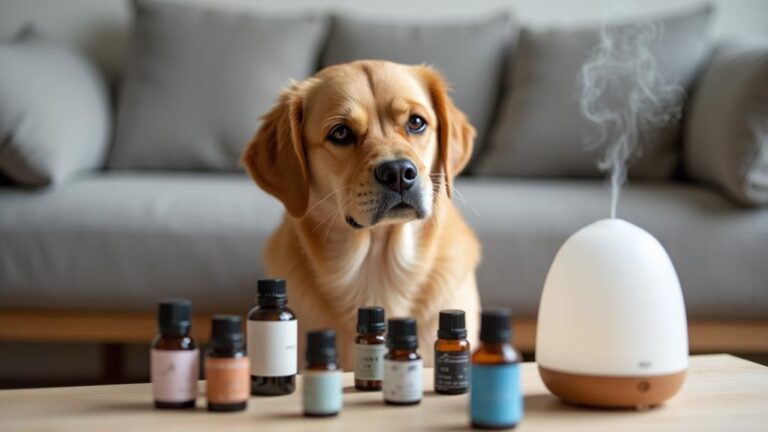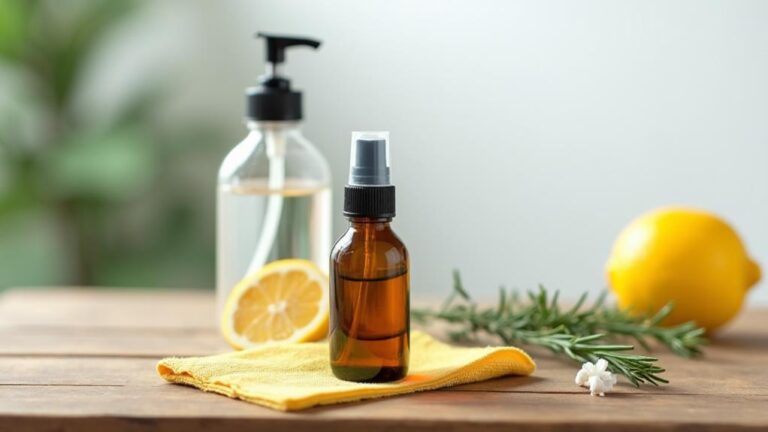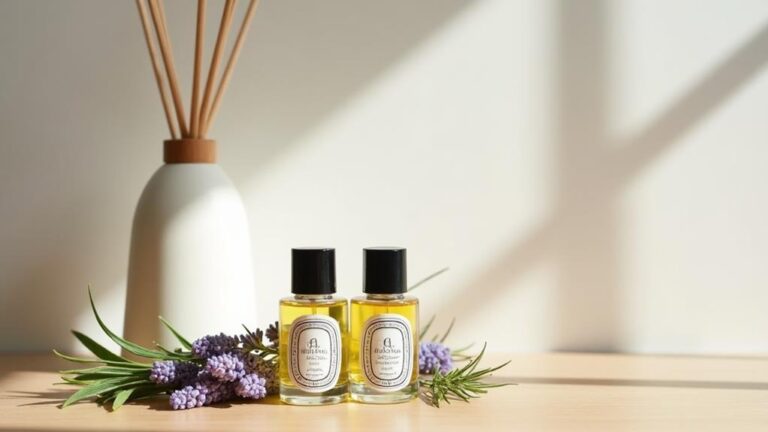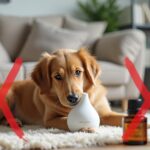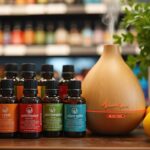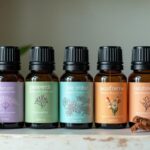A revitalizing change – or is it? As you walk into your home, you're likely to be hit with a mix of scents, from cooking odors to cleaning products. But what about essential oils – do they truly improve indoor air quality or are they just a pleasant addition to your space? With their antimicrobial and antioxidant properties, it's tempting to think they're the solution to all your air purification needs. But as you explore the world of essential oils, you'll find that the answer isn't as clear-cut as you might think – and it's vital to separate fact from fiction.
Key Takeaways
- Essential oils can neutralize airborne microorganisms, such as bacteria, viruses, and fungi, improving indoor air quality.
- Certain essential oils exhibit antimicrobial and antioxidant properties, beneficial in reducing airborne pathogens and pollutants.
- Essential oils can release particles into the air, exacerbating respiratory issues like asthma or allergies, negating potential benefits.
- The effectiveness of essential oils in improving indoor air quality varies depending on type, concentration, and method of use.
- Scientific evidence supporting essential oils' air-purifying abilities is often lacking, and claims should be viewed with skepticism.
What Causes Indoor Air Pollution
Several factors contribute to indoor air pollution, affecting the health and well-being of occupants.
When you consider the confined spaces of buildings, it's clear that air contaminants can accumulate quickly. You're likely to find a mix of pollutants, including particulate matter, gases, and volatile organic compounds (VOCs).
These air contaminants originate from various pollution sources, such as fuel combustion, tobacco smoke, and emissions from building materials.
As you assess the indoor air quality in your space, consider the role of human activities.
You might notice that cooking, cleaning, and personal care products release pollutants into the air. Additionally, poor ventilation and inadequate air exchange systems can exacerbate the problem.
You should also be aware of potential pollution sources like radon, asbestos, and lead, which can be present in building materials and soil.
Essential Oils Air Purification Claims
When evaluating the indoor air quality in your space, you may have come across claims that essential oils can help purify the air.
These claims are often based on the idea that essential oils have antimicrobial properties that can eliminate airborne pathogens and pollutants.
However, it is vital to approach these claims with a critical eye, as the regulation of essential oils is often lacking.
In the United States, for example, the essential oil industry is largely self-regulated, which means that manufacturers can make claims about their products without necessarily providing scientific evidence to back them up.
Oil marketing tactics often focus on the perceived benefits of essential oils, rather than the actual science behind them.
This can lead to exaggerated or misleading claims about the air-purifying abilities of essential oils.
As a result, it is vital to be aware of these tactics and to look for scientific evidence to support any claims made about essential oils.
In the next section, we'll take a closer look at the science behind essential oils and their potential impact on indoor air quality.
Science Behind Essential Oils
When you analyze essential oils, you'll find that their composition varies greatly depending on factors such as plant part, geographical location, and climate.
These oils are typically composed of volatile organic compounds (VOCs), including terpenes, esters, and aldehydes, which contribute to their distinct aromas and properties.
Understanding the specific extraction methods used to obtain essential oils from plants is also vital, as it can substantially impact their chemical makeup and potential impact on indoor air quality.
Oil Composition Varies
Most essential oils are complex mixtures of numerous bioactive compounds, primarily consisting of volatile organic compounds (VOCs) such as terpenes, esters, and aldehydes.
When you analyze the chemical composition of essential oils, you'll find that the proportions of these compounds vary greatly. This variation affects the oil properties, such as viscosity, solubility, and volatility, which in turn influence how the oil behaves in the air.
The chemical structures of the individual compounds also play a vital role in determining the oil's overall properties.
As you explore further into the composition of essential oils, you'll notice that the same oil can have different chemical profiles depending on factors like the plant's species, growing conditions, and extraction methods.
For instance, lavender oil from different regions can have distinct proportions of linalool and linalyl acetate, affecting its aroma and potential health benefits.
This variability highlights the importance of understanding the chemical composition of essential oils to accurately assess their impact on indoor air quality.
Volatile Organic Compounds
Chemical reactivity is a key characteristic of VOCs, influencing their interactions with other substances and the environment. This reactivity contributes to the formation of secondary organic aerosols, which can exacerbate air pollution. The following table illustrates some common VOCs found in essential oils, their properties, and potential effects:
| VOCs | Properties and Effects |
|---|---|
| Limonene | Known for its high chemical reactivity, contributing to secondary organic aerosol formation |
| Linalool | Exhibits moderate reactivity, potentially influencing indoor air quality |
| Pinene | Displays low reactivity, relatively stable in indoor environments |
| Benzene | Highly reactive, linked to adverse health effects |
| Toluene | Shows moderate reactivity, contributing to indoor air pollution |
As you consider the impact of essential oils on indoor air quality, understanding the VOCs they contain is essential. By acknowledging the properties and behavior of these compounds, you can make informed decisions about their use in your environment.
Plant Extraction Methods
As you explore the properties of essential oils, it's essential to understand the methods by which they're extracted from plants.
Two primary methods are employed to obtain essential oils: steam distillation and solvent extraction. Steam distillation involves subjecting plant materials to high-temperature steam, causing the plant's cells to rupture and release their volatile compounds.
These compounds are then collected and condensed, resulting in a concentrated essential oil.
Solvent extraction, on the other hand, uses a solvent such as ethanol or hexane to extract the essential oil from plant material.
This method is often used for delicate plants that may be damaged by heat or for plants that contain high levels of resin or waxy compounds. Solvent extraction can be more efficient than steam distillation but may result in lower-quality essential oils due to the potential for solvent residues.
Both methods require careful control of parameters such as temperature, pressure, and solvent concentration to produce high-quality essential oils.
Understanding these extraction methods is pivotal for evaluating the quality and potential impact of essential oils on indoor air quality.
Common Indoor Air Pollutants
As you assess your indoor air quality, you're likely to encounter volatile organic compounds (VOCs) and particulate matter (PM) from various sources.
VOCs can emanate from household products, such as cleaning supplies, air fresheners, and building materials.
You may also find PM sources, including combustion appliances, dust, and pet dander, contributing to indoor air pollution.
Volatile Organic Compounds
Volatile organic compounds (VOCs) are a major contributor to indoor air pollution.
When you release VOCs into the air, they can react with other pollutants to form ground-level ozone and particulate matter, which can exacerbate respiratory problems like asthma.
VOC emissions from indoor sources can come from various products, including paints, cleaning supplies, and pesticides. These products release VOCs as they evaporate or react with other substances.
You can also find VOCs in the materials used to construct your home, such as flooring, carpets, and adhesives.
Some VOCs, like formaldehyde, can be emitted from these materials over time. The chemical reactivity of VOCs can vary greatly depending on the compound and environmental conditions.
This makes it challenging to predict and mitigate their impact on indoor air quality.
Crucial to identify and reduce VOC emissions from indoor sources is to minimize their adverse effects on your health and indoor air quality.
Particulate Matter Sources
Your home's indoor air quality can be substantially impacted by particulate matter, a common indoor air pollutant. Particulate matter refers to small particles that are suspended in the air and can be inhaled, potentially causing health problems. You can reduce particulate matter in your home by understanding its sources and taking steps to minimize them.
| Particulate Sources | Emission Mechanism | Health Effects |
|---|---|---|
| Dust from carpets and upholstered furniture | Mechanical disturbance | Respiratory problems, allergies |
| Combustion appliances (e.g., wood stoves, fireplaces) | Incomplete combustion of fuel | Cardiovascular disease, lung cancer |
| Outdoor air pollution | Infiltration through ventilation systems or open windows | Respiratory problems, cardiovascular disease |
You can control particulate matter levels in your home by using HEPA air purifiers, removing carpets and upholstered furniture that generate dust, and maintaining your combustion appliances. Additionally, reducing outdoor air pollution can also help minimize particulate matter in your home. By understanding the sources of particulate matter, you can take steps to reduce its levels and improve your home's indoor air quality, ultimately protecting your health from air pollution.
Essential Oils and Volatile Compounds
Essential oils are complex mixtures of bioactive compounds that can substantially impact indoor air quality by releasing volatile compounds into the atmosphere.
You should consider the composition and concentration of essential oils, as they can vary greatly depending on the plant species, extraction method, and quality control.
When you use essential oils, they release volatile organic compounds (VOCs) that can react with other pollutants in the air, potentially altering indoor air quality.
The VOCs emitted by essential oils can also affect your scent preferences and aroma tolerance.
Some people may find the aroma of certain essential oils pleasant, while others may experience discomfort or irritation.
You may need to adjust the amount or type of essential oil used to accommodate individual sensitivities.
Additionally, the VOCs can interact with other indoor air pollutants, such as ozone and nitrogen dioxide, leading to the formation of secondary pollutants.
Understanding the complex interactions between essential oils, VOCs, and indoor air pollutants is vital for evaluating their impact on indoor air quality.
Effectiveness of Essential Oils
When it comes to improving indoor air quality, the effectiveness of essential oils is often a topic of discussion.
You may be wondering whether essential oils can truly purify the air you breathe. Research suggests that certain essential oils exhibit antimicrobial and antioxidant properties, which can be beneficial in reducing airborne pathogens and pollutants.
The essential benefits of essential oils lie in their ability to neutralize airborne microorganisms, such as bacteria, viruses, and fungi.
For instance, tea tree oil has been shown to inhibit the growth of airborne bacteria, while eucalyptus oil has been found to reduce the presence of airborne viruses.
Additionally, oil synergy – the practice of blending multiple essential oils – can enhance the effectiveness of individual oils.
By combining oils with complementary properties, you can create a potent blend that targets a range of indoor air pollutants.
However, the effectiveness of essential oils can vary depending on the type of oil, concentration, and method of use, as well as the specific air pollutant being targeted.
Potential Risks of Essential Oils
The use of essential oils for improving indoor air quality also raises concerns about potential health risks.
While essential oils can have therapeutic benefits, their use in indoor environments can pose risks to human health, particularly due to oil toxicity and individual sensitivities.
You should be aware of these potential risks when using essential oils in your home or workspace.
Potential Risks to Weigh:
- Respiratory problems: Essential oils can release particles into the air, exacerbating respiratory issues such as asthma or allergies.
- Skin irritation: Some essential oils can cause skin irritation or allergic reactions, especially if not diluted properly.
- Neurological effects: Certain essential oils, such as those containing high levels of menthol or eucalyptol, can cause neurological effects like headaches or dizziness.
- Interactions with medications: Essential oils can interact with medications, such as blood thinners, and decrease their effectiveness.
It is vital to weigh these potential risks and take necessary precautions when using essential oils to improve indoor air quality.
Understanding human sensitivity to essential oils and their potential toxicity is key to minimize adverse effects.
Alternative Air Purification Methods
Considering the potential risks associated with using essential oils for indoor air quality, you may want to explore alternative methods for purifying the air in your home or workspace.
One effective option is air scrubbers, which utilize advanced technologies to remove airborne pollutants and contaminants. These devices can be particularly useful in high-traffic areas or spaces with poor ventilation, as they can help to eliminate particulate matter, bacteria, and viruses.
Another alternative is smart filters, which are integrated into heating, ventilation, and air conditioning (HVAC) systems to capture airborne pollutants.
These filters are designed to maximize airflow while minimizing energy consumption, making them a cost-effective solution for improving indoor air quality. Smart filters can also be equipped with sensors that detect pollutant levels and adjust airflow accordingly, ensuring ideal air purification.
When selecting alternative air purification methods, consider factors such as pollutant removal efficiency, airflow rate, and maintenance requirements.
Making the Most of Essential Oils
Through careful selection and proper use of essential oils, you can maximize their benefits while minimizing potential risks to indoor air quality.
When choosing essential oils for indoor use, consider their chemical composition and potential interactions with other airborne pollutants.
Opt for high-quality, pure essential oils that are less likely to release volatile organic compounds (VOCs) into the air.
To make the most of essential oils, follow these guidelines:
- Select essential blends: Look for blends that combine oils with complementary aromatic benefits, such as lavender and chamomile for relaxation or eucalyptus and peppermint for invigoration.
- Use proper dilution: Dilute essential oils with a carrier oil or water to avoid overwhelming the air with VOCs.
- Choose the right diffuser: Select a diffuser that releases a gentle mist, which can help distribute the oil particles evenly throughout the air.
- Monitor indoor air quality: Use an air quality monitor to track the levels of VOCs and other pollutants in your indoor space, adjusting your essential oil use accordingly.
Frequently Asked Questions
Can Essential Oils Eliminate Mold and Mildew in Indoor Spaces?
You can use essential oils to inhibit mold and mildew growth, but they won't eliminate it entirely. Certain oils show promise in mold remediation, however, fungal resistance may develop, limiting their long-term effectiveness.
Are Essential Oils Safe for People With Allergies and Asthma?
You're about to diffuse essential oils in your home, but consider this: a study found 1 in 5 people with asthma reported worsened symptoms due to strong scents. Be cautious, as allergy triggers and scent sensitivity can be real concerns for you.
Can I Use Essential Oils in a Humidifier for Air Purification?
You can use essential oils in a humidifier, but check compatibility first. Certify the humidifier's materials won't degrade from oil exposure. Monitor oil diffusion rates to avoid over-saturation, which may reduce air purification effectiveness.
Do Essential Oils Interact With Other Indoor Air Cleaning Systems?
You'll encounter a million interactions between essential oils and other indoor air cleaning systems, but it's vital to ponder their compatibility. Mixing essential oils with air purifiers or scent diffusers can either enhance or hinder their effectiveness.
Are There Any Essential Oils That Repel Insects and Pests Indoors?
When considering insect-repelling options indoors, you find certain essential oils effective. Citronella candles, for instance, release a potent oil that deters mosquitoes, while Lemon's freshness also repels pests, providing a natural alternative to chemical-based solutions.
Conclusion
As you navigate the domain of indoor air quality, it's vital to separate fact from fiction. Like the sirens of Greek mythology, essential oils may lure you with promises of purification, but their effectiveness is often exaggerated. Instead of relying solely on essential oils, consider a multi-faceted approach that incorporates proven air purification methods. By doing so, you'll be better equipped to chart a course through the intricacies of indoor air quality and create a healthier environment.








